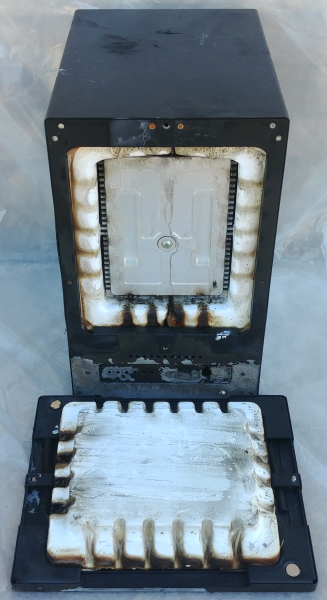In the tech world, ioSafe is already well known for its fire- and water-proof technologies so I was a bit surprised when they asked if I would be testing these capabilities in my review. They explained that this was a key feature of the 1019+ and were proud to show it off. Needless to say, I couldn't let them down. Not to mention, how often do you get to take a nicely equipped NAS device and light it on fire?
To test the 1019+'s fire-proof capabilities, I enlisted the the help of my two sons, Caden and Ryan, as well as my neighbor Tom, whose fire pit we'll be using. The plan was to build a nice fire around the NAS, let it cook for about 25 minutes and then put it out with a garden hose. This way we'd be simulating what would happen if your home or office caught on fire and was put out by the fire department.

The 1019+ was placed on a small wood platform that I built and surrounded by some cardboard, split logs and yard waste. We also added a little bit of lighter fluid to help move things along.

I used an infrared thermometer to keep an eye on the temperatures. For the most part, the temperature ranged somewhere between 500° and 700° F. However, there were a few times where I saw a temperature in excess of 900° F.

When the flames died down some, we did notice some white smoke coming out of the vents on the front and back of the unit. I'm guessing that this was ioSafe's DataCast technology at work.

After about 25 minutes, we put the fire out with a garden hose. The 1019+ was thoroughly doused, with water being sprayed in all of the exposed vents and holes.


As you can see, the 1019+ looks like it has been to hell and back. In addition to its peeling paint, the front LEDs, power button, and rear cooling fans are pretty much gone. Amazingly enough, the eSATA and ethernet ports are still there.

Behind the fireproof, outer door, things don't look nearly as bad. The inner, aluminum chamber was a bit dirty but nothing like the outside of the device.


I'm happy to say that the hard drives came through the ordeal unscathed. None of them had any physical damage and I was able to view all of the volumes when they were connected to a computer. Unfortunately, I didn't have another Synology-based NAS available so I was not able to fully restore the RAID volume but I don't expect there would be any issues here.
I should also point out that if you buy an ioSafe 1019+ with factory-installed hard drives, it will come with two years of the company's Data Recovery Service (DRS). This covers the device for any data loss due to things like fire, flood, disk failure or even human error. The service provides comprehensive protection against the costs associated with data recovery, including access to ioSafe's experts, global mail-in coverage and replacement hardware pre-loaded with the recovered data. If, for some reason that ioSafe cannot recover your data in house, they will send it to a third party data recovery company like DriveSavers. ioSafe also gives customers the ability to extend the DRS coverage, as well as the warranty, to five years for a fee.

